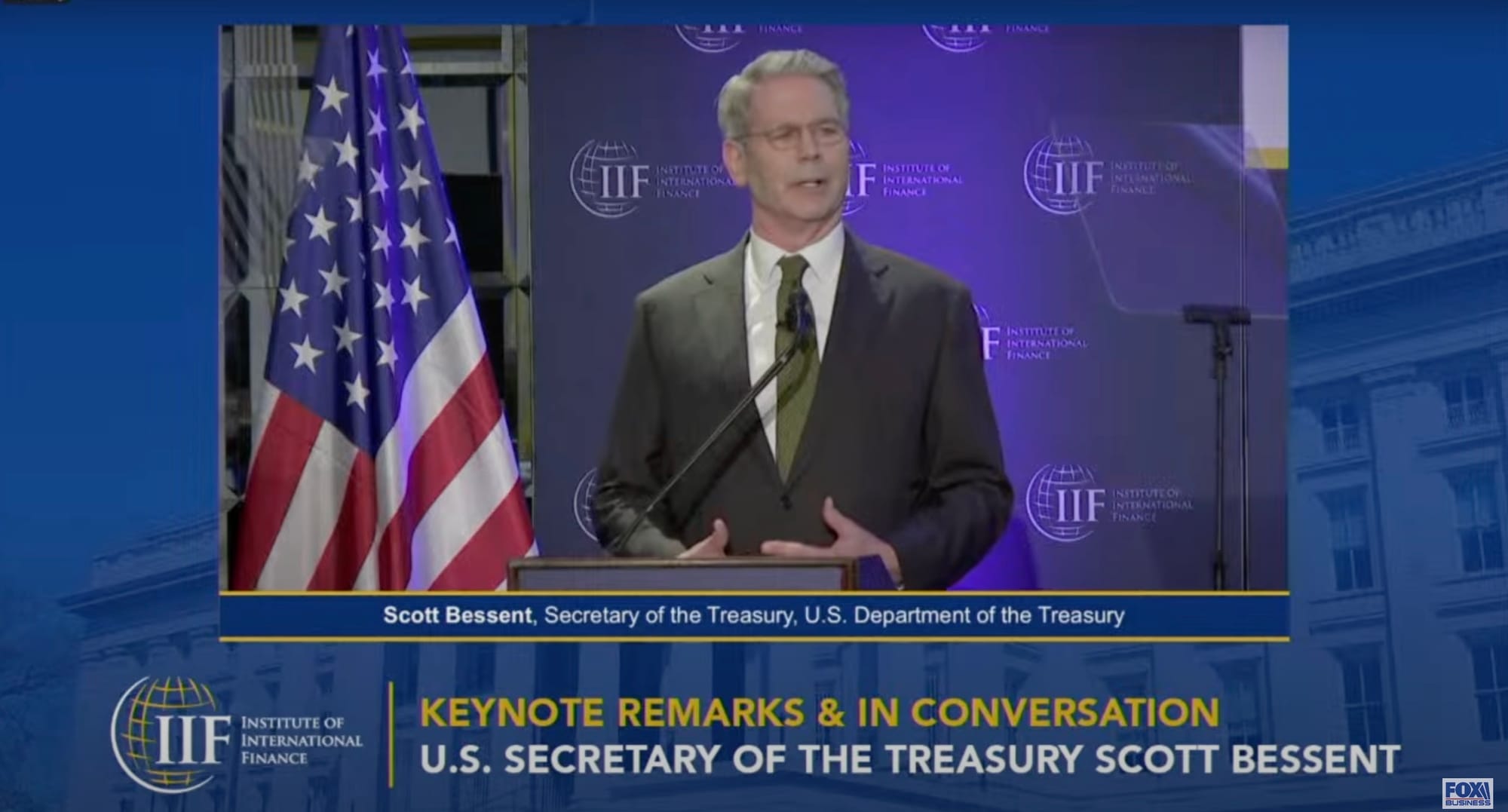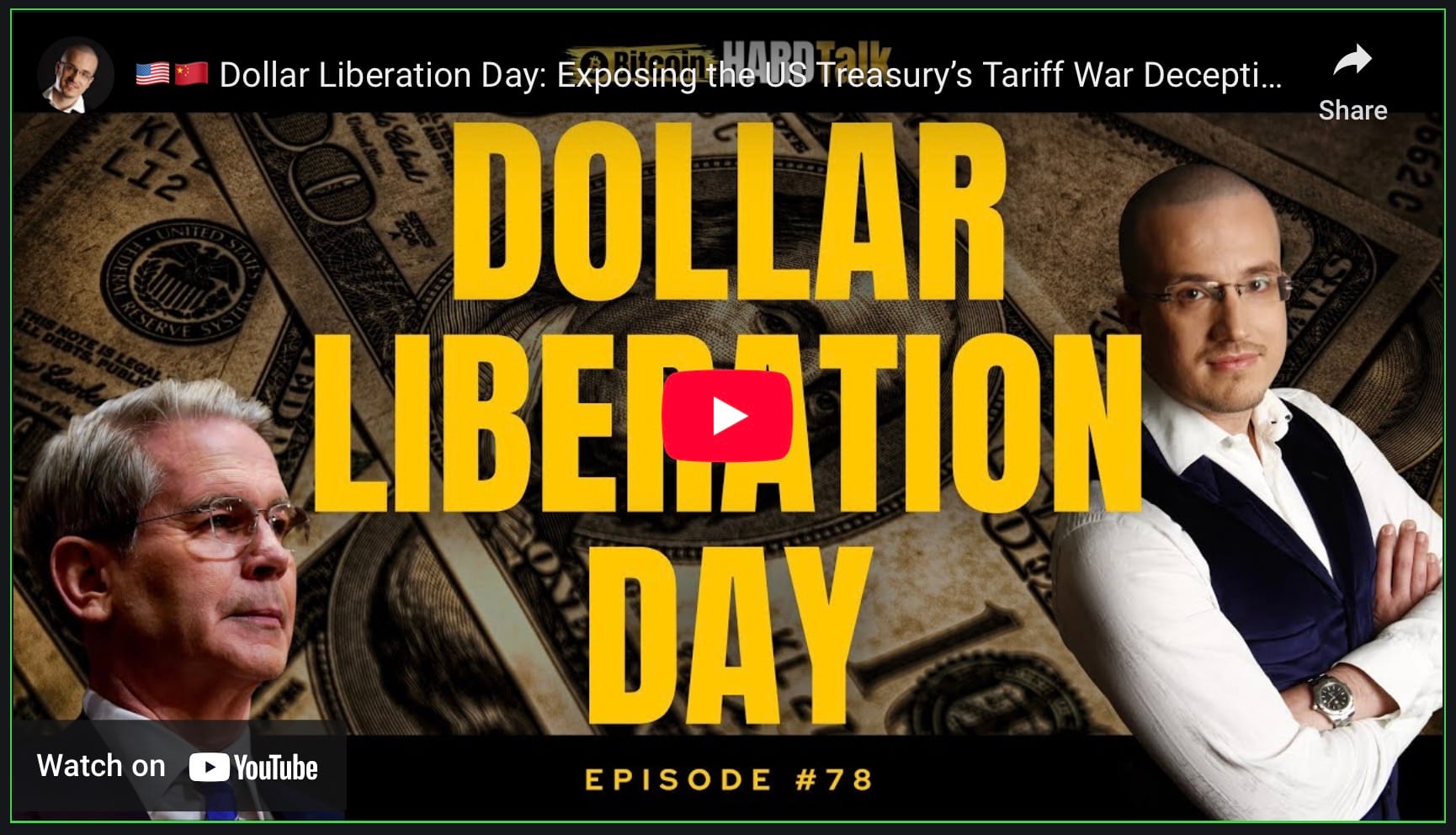Dollar Liberation Day

In this monologue Simon interprets contemporary US economic policy, particularly tariffs and the rhetoric surrounding them (analyzed through Scott Bessent's keynote address to the IIF), not as efforts to benefit "Main Street" but as mechanisms for a massive wealth transfer to "Wall Street" and the management of a controlled decline of the US dollar and empire.

In this monologue he interprets contemporary US economic policy, particularly tariffs and the rhetoric surrounding them (analyzed through a Scott Bessent keynote address), not as efforts to benefit "Main Street" but as mechanisms for a massive wealth transfer to "Wall Street" and the management of a controlled decline of the US dollar and empire.
He posits the existence of a clandestine "Proof-of-Weapons Network"—comprising central banks, intelligence agencies, and controlled governments manipulating global events for the benefit of multinational corporations and financial elites.
He weaves a revisionist historical narrative, reinterpreting major 20th and 21st-century events as orchestrated steps in this network's long-term strategy. Amidst this perceived systemic corruption and planned decline. He then champions Bitcoin as a decentralized counterforce ("proof-of-work") offering self-sovereignty, while warning against elite attempts to co-opt it through centralized financial products.
The core message advocates for rejecting mainstream narratives, understanding the hidden machinations of power, and embracing Bitcoin self-custody as a means of financial liberation and resistance against encroaching technocratic control.
Do listen to the original address by Scott Bessent - there are many very significant details in addition to those that Simon extracts, not least the abandonment of all of the ESG and DEI nonsense that we have been subject to over the last decade or more. Also the Energy Policy remarks represent a complete reversal - abundant energy is now the mandate.
Simon Translates
Introduction: Setting the Stage for "Re-translation"
Simon states that he intends to dissect an interview featuring US Treasury Secretary nominee Scott Bessent, arguing that Bessent's statements represent a deceptive narrative designed to mislead the public.
He reminds you that he is an experienced analyst of finance, monetary reform, and Bitcoin, claiming a track record of accurate, albeit initially controversial, predictions regarding geopolitical and economic events (citing his forecasts on the Ukraine war's implications, the rise of BRICS, and Trump's political trajectory).
His central thesis is that official rhetoric surrounding economic policies like tariffs, framed as beneficial redistribution ("Wall Street to Main Street" or "Make America Great Again"), masks a deeper reality: a deliberate "financial terrorism" orchestrated by elites to engineer a massive wealth transfer from the populace to powerful multinational corporations and financial institutions.
You are urged to suspend disbelief and follow his "re-translation" of establishment narratives into what he perceives as their true meaning.
The "Proof-of-Weapons Network": A Framework for Control
Central to Simon's analysis is the concept of the "Proof-of-Weapons Network," an analogy derived from Bitcoin's "proof-of-work." He describes this network as operating in three interconnected layers:
- Layer One: Central Banks & Financial Institutions: Led by the Federal Reserve (and analogous institutions like the Bank of England and ECB), this layer operates a "debt-based Ponzi scheme." Simon argues that central banks, owned by and working for large private banks, create money through debt issuance without creating the corresponding interest, necessitating perpetual debt cycles. Institutions like the IMF and World Bank are portrayed as tools to enforce dollar-denominated debt globally, often through "economic hitmen" tactics, destabilizing nations to extract resources and create demand for the dollar. This system inherently leads to inflation (a "hidden tax"), wealth concentration, trade deficits in the host country (USA), and ultimately benefits financial elites who can borrow cheaply while burdening the populace and government with debt.
- Layer Two: Intelligence Agencies ("Deep State"): Comprising entities like the CIA, Mossad, and MI6, this layer is depicted as executing the network's agenda through covert operations. Simon claims these agencies orchestrate wars, assassinations, blackmail, and regime changes, often funding militia groups (like M23, ISIS, Al-Qaeda) under false pretenses (e.g., religious extremism) to destabilize regions, secure resources for corporations, justify military spending (creating profits for contractors), and control narratives through media manipulation. He cites examples like operations in Africa and the funding of conflicts to generate trillions in printable money.
- Layer Three: Government: Politicians in governments (Congress, Senate, etc.) are presented as "installed people," funded and controlled by corporate interests (Layer 1) and managed or coerced by intelligence agencies (Layer 2). Their role is to enact policies favorable to the network and deliver acceptable public narratives (like Bessent's speech) that obscure the true objectives. Simon contends that democratic processes and ideological divides (Left vs. Right, Republican vs. Democrat) are largely manufactured distractions.
Historical Reinterpretation and the Bretton Woods System
Simon provides a revisionist account of modern history through the lens of the Proof-of-Weapons Network. He argues:
- World War I was orchestrated after the Federal Reserve's creation (1913) to reset the world order, transfer gold/power from the Bank of England to the Fed, create Israel as a strategic outpost (linked to Rothschild financing and the Balfour Declaration), and establish communism in Russia (also funded by the same financiers) to create enduring geopolitical tension (Capitalism vs. Communism) profitable for the network.
- World War II was similarly manipulated, with both sides receiving funding, facilitating events like the Haavara Agreement, and culminating in the consolidation of global gold reserves under US control (Fort Knox).
- The Bretton Woods Agreement (1944) formalized this US-centric system. Simon interprets it not as a stabilizing force but as a mechanism to export the dollar globally via the IMF (currency exchange pegged to gold-convertible dollar) and the World Bank (dollar loans conditional on adopting central banking). This system, he claims, was designed to perpetuate debt, facilitate resource extraction (neocolonialism disguised as democracy export), hollow out US manufacturing (due to the strong dollar required for reserve status), and create profitable conflicts (Cold War, Korea, Vietnam). The education system (promoting Keynesian economics) and media were used to reinforce this system.
- The 1971 "Nixon Shock" (ending dollar-gold convertibility) is seen as a default necessitated by excessive war spending (Vietnam), further entrenching the fiat dollar system backed by military power (petrodollar system).
Deconstructing Bessent: Tariffs, Global Reset, and Managed Decline
Simon meticulously analyzes segments of Scott Bessent's speech, interpreting nearly every statement as the opposite of its surface meaning: - Critique of IMF/World Bank: Bessent's calls for reforming these institutions are seen not as genuine attempts at improvement but as part of a controlled dismantling of the very tools that propped up the dollar-centric order. This signals a strategic retreat and weakening of the dollar, blaming the institutions for failures caused by the network itself.
- Trade Imbalances & China: Bessent's focus on trade imbalances and China's role is dismissed as dishonest. Simon argues the imbalances are inherent features of the reserve currency system (Triffin's dilemma) designed by the network. China's rise and state-controlled model are contrasted favorably with the perceived asset stripping and infrastructure decay in the US. The "trade war" is depicted as a façade; Simon claims BRICS/GCC have already "won," and the US elite are managing a negotiated retreat.
- Tariff Policy: The core of the critique. Tariffs are presented as a tool not to rebuild US manufacturing but to inflict economic pain on Main Street (disrupting supply chains, raising prices), create volatility profitable for hedge funds connected to the network, and provide leverage for multinational corporations (who own Trump and have global operations) to acquire distressed assets domestically and internationally as the global order resets. Trump's "Liberation Day" rhetoric is framed as celebrating the liberation of the world from the dollar.
- Europe & Security: Calls for Europe to increase defense spending are interpreted as forcing Europe to fund the military-industrial complex and bear the costs of wars (like Ukraine, instigated by the CIA/NATO) designed to weaken Europe economically and subordinate it further, while the US strategically withdraws global leadership.
- Argentina (Milei): Presented as a model case where an installed leader facilitates privatization of assets for corporations and repatriation of gold to shore up Western reserves ahead of the dollar's decline.
- Energy Policy: Discussions about energy access and technology neutrality are seen as a sales pitch for US tech corporations to profit from the necessary rebuilding and development in the "liberated" Global South, financed by BRICS/GCC capital, as Western elites redeploy their capital globally.
The Role of Bitcoin: Solution and Target
Throughout the monologue, Bitcoin ("proof-of-work") is positioned as the antithesis to the "Proof-of-Weapons Network." Simon, an early Bitcoin advocate, sees it as: - Hard Money Alternative: A decentralized, fixed-supply asset outside the control of central banks and the debt-based system.
- Tool for Self-Sovereignty: Enabling individuals to own and transact value without intermediaries (banks, governments), offering protection against inflation and confiscation.
- Target of Co-option: Simon warns urgently that the network elites, recognizing Bitcoin's threat/potential, are actively trying to control it. He views the creation of Bitcoin ETFs (BlackRock), the promotion of lending against Bitcoin (citing Celsius/FTX collapses as engineered traps), and the push for stablecoins and centralized crypto infrastructure (Cantor Fitzgerald, Tether) as sophisticated schemes to separate users from self-custody, centralize control, and ultimately confiscate Bitcoin during manufactured crises or margin calls. He predicts a future attempt to scam holders into leveraging their Bitcoin.
Conclusion: Call for Decentralization and Resistance
Simon concludes by reiterating his grand narrative: the world is undergoing a managed transition away from US hegemony, orchestrated by global elites using figures like Trump and policies like tariffs to cover their asset stripping and repositioning. He argues the real conflict is not Left vs. Right or nation vs. nation, but Centralization vs. Decentralization. He urges listeners to see through the manufactured divisions and psyops. The proposed path to resistance and self-preservation involves: - Understanding the Game: Recognizing the manipulations and following the money (elites moving into gold and Bitcoin).
- Embracing Bitcoin Self-Custody: Holding Bitcoin directly ("not your keys, not your coins") to maintain sovereignty.
- Rejecting Debt & Fiat: Opting out of the debt-based system and using hard money.
- Localism & Decentralization: Building local resilience (peaceful non-compliance) and supporting decentralized alternatives in technology and social organization. He frames adopting Bitcoin in self-custody as a peaceful act of defiance ("an FU to the system") that defunds the "Proof-of-Weapons Network" and empowers individuals. He expresses cautious optimism that while elites attempt to control the transition, the decentralized nature of Bitcoin offers a path towards a potentially more equitable future, provided individuals remain vigilant and prioritize self-sovereignty.
None of the above should surprise you
Recall that we have already discussed many of these lies extensively back in my reviews of "180 degrees" and "The Falsification of History".